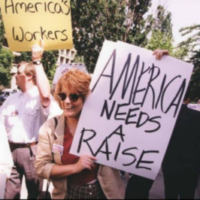Workers’ Wages Will Increase in 52 Cities, Counties, and States on January 1—Many Reaching or Surpassing $15 an Hour—With Another 23 Jurisdictions Set to Raise Pay Later in the Year
A record-breaking number of jurisdictions will raise their wage floors in the coming year: A total of 74, cities, counties, and states will raise their minimum wages in 2021, many to $15 per hour or more. These raises are a combination of new laws adopted in 2020, scheduled step increases, and cost-of-living adjustments.
This is the highest number of jurisdictions raising pay since the Fight for $15 and a union began in November 2012, demonstrating the continued strength of the movement. Since the beginning, the Fight for $15 has been led by Black and brown workers,[1] and workers of color continue to lead the movement for higher wages, collective bargaining rights, and safety and dignity on the job.
Summary of Wage Increases in 2021
On January 1, 2021 (December 31, 2020 for workers in New York) the minimum wage will increase in 20 states and 32 cities and counties. In 27 of those jurisdictions, the wage floor will reach or surpass $15 per hour. Later in 2021, five additional states and 18 local jurisdictions will also increase their wage floors—13 of them to $15 or more. By the end of 2021, 40 cities and counties will have met or exceeded a $15 minimum wage.
In total, 24 states and 50 municipalities will increase wages for the lowest-paid workers in the last day of 2020 or sometime in 2021. (Florida will increase wages twice in 2021, but is counted only once in the year’s grand total). Below is a summary of what to expect in 2021:
- Minimum wages will increase in 20 states and 32 cities and counties on or around New Year’s Day, for a total of 52 jurisdictions. (See Table 1).
- In 27 cities and counties, the minimum wage will reach or exceed $15 per hour—including Hayward, Novato, and Sonoma, CA, which will have lower minimum wages for small employers, as well as New York City, which requires a $15 minimum wage as part of a statewide wage order enacted in 2016.
- In 11 states, the minimum wage will increase due to cost-of-living adjustments based on the Consumer Price Index (CPI).
- In 24 cities and counties, the wage floor will also be adjusted for inflation, including the California cities of Novato, Petaluma, San Carlos, and Santa Rosa, and Seattle, WA, which will add CPI to scheduled step increases for some or all of employers in their jurisdictions.
- Later in 2021, five states and 18 cities and counties will follow with additional minimum wage increases, for a total of 23 jurisdictions. (See Table 2).
- Among them is Florida, which will raise its wage floor twice: On January 1, as a CPI increase under the state’s 2004 constitutional amendment; and on September 30, as a first scheduled increase under the most recent constitutional amendment approved by voters in November 2020.
- In 13 cities, the minimum wage will reach or exceed $15 per hour—including the California cities of Berkeley, Emeryville, Fremont, Milpitas, and San Francisco, as well as Washington, D.C.—which have already reached or surpassed a $15 minimum wage and are expected to raise wages further; and Chicago, IL and Montgomery County, MD, which will have lower minimum wages for small or mid-size employers.
- In 9 cities and counties, the minimum wage will increase due to cost-of-living adjustments, including Fremont, CA, which is adding a cost-of-living adjustment to its last scheduled step increase.
During the COVID-19 Pandemic, Raising Wages Is More Crucial Than Ever
The upcoming minimum wage raises are needed now more than ever. During the greatest health and economic crisis of our lifetimes, millions of people across the country are struggling to feed their families and avoid homelessness. Many of those who are struggling are workers on the COVID-19 frontlines, who provide essential services to their communities, but due to occupational segregation and other effects of systemic racism, are often underpaid and lack crucial safety protections.
The workers who are feeding and caring for our communities through this pandemic need higher wages so that they can live, thrive, and support their own families in addition to everyone else’s. Frontline workers of color across the country are demanding premium and hazard pay along with other essential protections. If politicians want to do more than pay lip service to frontline workers, they should listen to them and prioritize raising wages—both in the form of premium pay and more permanent increases, like those going into effect in 2021.
2020: A Year of Historic Wins for the Movement for Higher Wages: Florida Joins Seven States and Washington, D.C. on a Path to $15; Virginia, Vermont, and Additional Cities Adopt Higher Wages
Among the states set to raise wages in 2021 is Florida, a red state where voters approved a ballot initiative raising the minimum wage to $15 by 2026. Florida joins seven other states—California, Connecticut, Illinois, Maryland, Massachusetts, New Jersey, and New York—plus the District of Columbia, in voting on or enacting a plan to raise the state minimum wage to $15 or higher.
The Economic Policy Institute (EPI) estimates that with Florida joining the seven states plus D.C., approximately 42 percent of the U.S. workforce will be covered by $15 minimum wage laws [2] by 2026.
In addition to Florida, Virginia also made history by adopting a minimum wage law that gradually increases its wage floor to $12 by 2023 and offers a path to $15 by 2026. The Vermont Legislature also adopted a new law, raising the state’s wage floor to $12.55 by 2022, and requiring the release of a report in early 2021 that assesses the possibility of eliminating the sub-minimum tipped and youth wages. A number of cities also adopted higher minimum wage laws for the first time in 2020: Burlingame, CA ($15 by 2021), Half Moon Bay, CA ($15 by 2021); Hayward, CA ($14-$15 by 2021–2023); San Carlos, CA ($15 by 2021); Portland, ME ($15 by 2024); and Rockland, ME ($15 by 2024).
Black and Brown Workers Are at the Forefront of the Movement for Higher Wages
The Fight for $15 has been led by Black and brown workers from the outset.[3] Responding to skyrocketing inequality and Congress’s refusal to raise the federal minimum wage, fast-food workers in New York City staged a strike in late 2012, which spread across the country, scoring early wins in the Washington cities of SeaTac and Seattle, and becoming known as the Fight for $15 and a union. Since then, the Black and brown worker-led movement has amassed victory after victory, winning over $68 billion for more than 22 million workers nationwide,[4] and shaping the national debate on economic and racial justice.[5]
The importance of the movement for higher wages for workers of color cannot be overestimated: Per EPI’s estimates, nearly 1 in 3 Black workers, 27 percent of Latinx workers, and 17 percent of other workers of color currently earn low wages and would benefit from a federal $15 minimum wage.[6] These disparities are the result of structural racism—with an economic system rooted in chattel slavery and genocide, workers of color have and continue to be shunted into the lowest paid jobs with the least protections.
But the power of workers of color coming together and organizing cannot be underestimated—and the raises going into effect in 2021 suggest that the Black and brown worker-led movement for raising wages continues to grow its momentum.
The Limitless Future of the Movement for Higher Wages
The victories this movement have amassed are monumental, but the work of winning higher wages is far from over. There are 20 states still stuck at the federal level of $7.25 per hour—with state legislators who have turned their backs on their constituents by refusing to raise the minimum wage, even as the popularity of raising wages grows. Meanwhile, Congress has refused to raise the federal minimum wage for more than ten years.
As the cost of living and inequality continue to rise, it is also becoming increasingly apparent that the wage floor needs to move above $15. Workers around the country are making their demands known. Already, some local jurisdictions have approved minimum wages above $15, including Belmont, CA ($15.90 by 2021), Sonoma, CA ($16-$17 by 2023), and Denver, CO ($15.87 by 2022). Others have begun the process of calling for similarly robust wages, such as Aurora, CO, which nearly approved a $17 minimum wage in 2020,[7] and Hawaii, where advocates and community leaders began pushing for a $17 minimum wage in 2019.[8]
All workers deserve to live and thrive. With a new year and new White House administration in sight, opportunities for change abound. Throughout the past year, workers have demonstrated their power in the face of tremendous uncertainty and extreme retaliation from some of the largest corporations in the world—walking off the job to protest unsafe conditions amid the pandemic, demanding premium pay for their work, and more. At the same time, workers have continued to organize for a $15 minimum wage and higher.
The new administration and Congress must respond to workers’ and communities’ demands and deliver a just recovery from this crisis, while centering workers and unemployed people in all policy—especially workers in underpaid jobs and Black and Indigenous workers and other workers of color. That means strengthening unemployment insurance and making sure all people out of work are included, including undocumented workers, prioritizing paid leave and worker safety, and—crucially—finally passing a federal wage floor of $15 or higher.
For their part, policymakers at the state and local level can respond to both the particular demands and the particular opportunities of this time by listening to workers and adopting wage floors that move beyond a bare minimum and come closer to a living wage.
Workers have made it clear that they will not go back to the way things were before this pandemic. Lawmakers should follow their lead.
Download the full report to see tables and endnotes.
Endnotes
[1]. Kirsten West Savali, “How Racial Injustice is Now Driving the ‘Fight for $15’,” The Root Magazine, reprinted at Mississippi State Conference NAACP, April 17, 2015, http://naacpms.org/how-racial-injustice-is-now-driving-the-fight-for-15/.
[2]. Unpublished estimate by the Economic Policy Institute. Estimate includes the eight states on a path to $15, the District of Columbia, and Washington State which is likely to be at or above $15 by 2026.
[3]. Kirsten West Savali, op. cit.
[4]. This figure includes state and city minimum wage increases approved as of November 2018. An updated estimate is forthcoming in early 2021. See Yannet Lathrop, Impact of the Fight for $15: $68 Billion in Raises, 22 Million Workers, National Employment Law Project, November 2018, https://www.nelp.org/publication/impact-fight-for-15-2018/.
[5]. Caitlin Byrd, “2020 Democratic Race Renews Focus on $15 Minimum Wage in South Carolina,” The Post and Courier, July 28, 2019 (updated September 14, 2020), https://www.postandcourier.com/politics/2020-democratic-race-renews-focus-on-15- minimum-wage-in-south-carolina/article_eb359f78-acb1-11e9-ab9a-f74f01db5743.html.
[6]. David Cooper, Raising the Federal Minimum Wage to $15 by 2025 Would Lift Wages for Over 33 Million Workers, Economic Policy Institute, July 17, 2019, https://www.epi.org/publication/minimum-wage-15-by-2025/.
[7]. Andrea Flores, “Aurora City Council Rejects Minimum Wage Hike in Close Vote,” CBSN Denver, November 3, 2020, https://denver.cbslocal.com/2020/11/03/aurora-business-owners-minimum-wage-hike-coronavirus-concerns/.
[8]. See Hawai’i Appleseed, The Effects of Boosting Hawaii’s Minimum Wage, April 16, 2019, https://hiappleseed.org/publications/the-effects-of-boosting-hawaiis-minimum-wage/; and Paxton Parker, “How a Living Wage Would Help Lots of Hawaii Workers,” Honolulu Civil Beat, December 27, 2019, https://www.civilbeat.org/2019/12/how-a-living-wage-would-help-lots-of-hawaii-workers/.




